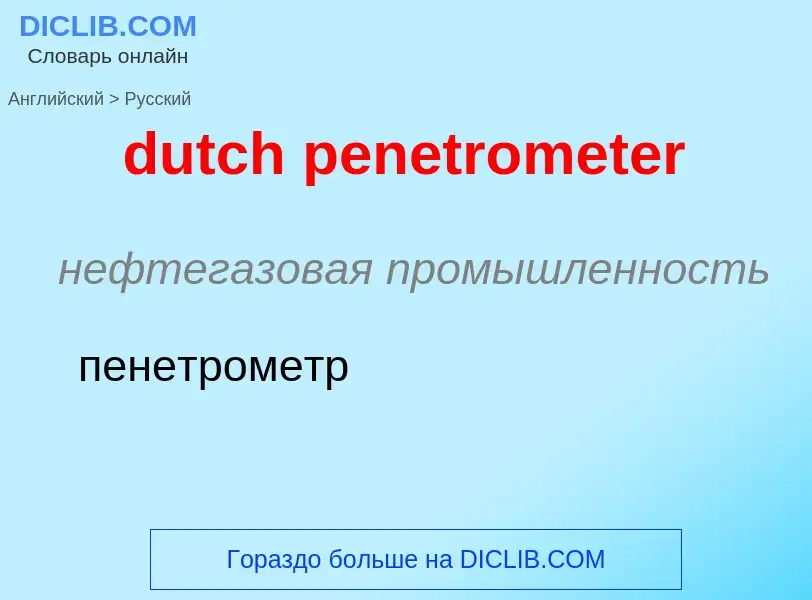Tradução e análise de palavras por inteligência artificial ChatGPT
Nesta página você pode obter uma análise detalhada de uma palavra ou frase, produzida usando a melhor tecnologia de inteligência artificial até o momento:
- como a palavra é usada
- frequência de uso
- é usado com mais frequência na fala oral ou escrita
- opções de tradução de palavras
- exemplos de uso (várias frases com tradução)
- etimologia
dutch penetrometer - tradução para russo
нефтегазовая промышленность
пенетрометр
['neð(ə)ləndə]
прилагательное
общая лексика
нидерландец, голландец
существительное
общая лексика
уроженец или житель Нидерландов
нидерландский подданный
голландец
голландка
Wikipédia
The Fall cone test, also called the cone penetrometer test or the Vasiljev cone test, is an alternative method to the Casagrande method for measuring the Liquid Limit of a soil sample proposed in 1942 by the russian researcher Piotr Vasiljev (Russian: Пё́тр Васи́льев) and first mentioned in the russian standard GOST 5184 from 1949. It is often preferred to the Casagrande method because it is more repeatable and less variable with different operators. Other advantages of the fall cone test include the alternative to estimate the undrained shear strength of a soil based on the fall cone factor K.
In the Fall cone test, A stainless steel cone of a standardized weight and tip angle is positioned so that its tip just touches a soil sample. The cone is released for a determined period of time, usually 5s, so that it may penetrate the soil. Several standards around the globe exist. Main differences are related to the cone tip angle and cone mass. The liquid limit is defined as the water content of the soil which allows the cone to penetrate a determined depth during that period of time. The penetration depth at which the liquid limit is measured depends on the standard and method adopted. For example, one of the most recognized standards is the BS 1377. The British standard defines the liquid limit as the water content of a soil at which a 80g, 30º cone penetrates 20mm. Because it is difficult to obtain a test with exactly 20 mm penetration, the procedure is performed multiple times for a range of water contents and the results are interpolated. Furthermore, the undrained shear strength for each one of those measured water content can be computed as proposed by Hansbo:
where,
cu = Undrained shear strength;
K = Fall cone factor;
Q = Cone weight;
h = Penetration depth.
The fall cone factor can vary between 0.5 and 1.33. It can be estimated as proposed by Llano-Serna and Contreras:
where,
= Equivalent rate of rotation when measuring the undrained shear strength using the mini shear vane test.
A summary of different existing standards is shown in the table below:

![Dutch family in [[Java]] c. 1903 Dutch family in [[Java]] c. 1903](https://commons.wikimedia.org/wiki/Special:FilePath/COLLECTIE TROPENMUSEUM W.L. Harmsen met familie en gasten in de tuin van zijn huis te Tjikadongdong TMnr 60052275.jpg?width=200)
![2000 U.S. Census]] 2000 U.S. Census]]](https://commons.wikimedia.org/wiki/Special:FilePath/Census Bureau Dutch in the United States 2000.png?width=200)
![Voortrekkers]]}} in South Africa Voortrekkers]]}} in South Africa](https://commons.wikimedia.org/wiki/Special:FilePath/Charles Edwin Fripp00.jpg?width=200)
![IPA]] symbols added for pronunciation comparison IPA]] symbols added for pronunciation comparison](https://commons.wikimedia.org/wiki/Special:FilePath/Comparison of English, Dutch and German sentence.png?width=200)
![migrants]] arriving in [[Australia]] in 1954 migrants]] arriving in [[Australia]] in 1954](https://commons.wikimedia.org/wiki/Special:FilePath/Dutch Migrant 1954 MariaScholte=50000thToAustraliaPostWW2.jpg?width=200)

![Middelburg]], [[Netherlands]] Middelburg]], [[Netherlands]]](https://commons.wikimedia.org/wiki/Special:FilePath/Dutch street.jpg?width=200)
![Traditional [[Cape Dutch architecture]] ([[Swellendam]]) Traditional [[Cape Dutch architecture]] ([[Swellendam]])](https://commons.wikimedia.org/wiki/Special:FilePath/Dutcharchitecture2.png?width=200)

![liberation of the Netherlands]] at the end of World War II on 7 May 1945 liberation of the Netherlands]] at the end of World War II on 7 May 1945](https://commons.wikimedia.org/wiki/Special:FilePath/Een uitzinnige menigte verwelkomt de Canadese bevrijders in Utrecht - An ecstatic crowd in Utrecht welcomes the Canadian liberators (4502667274).jpg?width=200)
![Paraná]], Brazil. Mill and houses in Dutch architecture on the left Paraná]], Brazil. Mill and houses in Dutch architecture on the left](https://commons.wikimedia.org/wiki/Special:FilePath/Moinho Parque Historico Carambei.jpg?width=200)
![SNP]] variation in the Netherlands SNP]] variation in the Netherlands](https://commons.wikimedia.org/wiki/Special:FilePath/NL PCs abdellaoui.jpg?width=200)
![ANV]]; it states the dividing line between both areas lies where "the great rivers divide the Brabantic from the Hollandic dialects and where Protestantism traditionally begins".</ref> ANV]]; it states the dividing line between both areas lies where "the great rivers divide the Brabantic from the Hollandic dialects and where Protestantism traditionally begins".</ref>](https://commons.wikimedia.org/wiki/Special:FilePath/NorthernDutch.png?width=200)

![The [[Act of Abjuration]], signed on 26 July 1581, was the formal declaration of independence of the Dutch Low Countries. The [[Act of Abjuration]], signed on 26 July 1581, was the formal declaration of independence of the Dutch Low Countries.](https://commons.wikimedia.org/wiki/Special:FilePath/Plakkaat van Verlatinghe.jpg?width=200)

